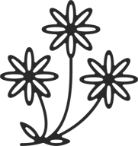
-
Why we like this plant
Choose ‘Queen Bee’ for its cheery yellow blooms that brighten any space, from flowerbeds to patio pots. With a lovely scent, fuss-free care and consistent flowering, it’s the kind of rose that complements both lively and calm garden scenes—offering repeat blooms without demanding attention.
-
About this plant
Rosa ‘Queen Bee’ is a spirited floribunda rose boasting soft yellow-golden blooms with a blush of apricot at their centres. The semi-double, ruffled flowers emit a gentle, fruity fragrance and appear abundantly from early summer through autumn. Backed by glossy, dark-green foliage and a neat, compact form, this rose adds warmth and charm to borders, containers, or patio spaces, making it an adaptable favourite in many gardens.
-
Key features
- Yellow-golden semi-double blooms (7–9 cm across)
- Delicate fruity scent
- Repeat flowering from June to October
- Glossy, disease-resistant foliage
- Compact, upright habit ideal for small spaces
-

Eventual height and
spreadHeight: 60–90 cm | Spread: 50–80 cm
-

Growth
habitCompact, bushy and upright, with sturdy stems supporting abundant, uplifting flowers above tidy foliage.
-

Moisture
Moist but well‑drained
-

Position in
the GardenThis rose flourishes in full sun and is ideal for patio pots, sunny garden borders, or as a charming accent near seating areas.
Planting guide
Plant in a sunny, sheltered spot with fertile, free-draining soil. Blend compost or well-rotted manure into the planting hole, ensure the crown is just above soil level, and water well to settle. Keep the soil consistently moist during establishment and feed with rose fertiliser in spring and after the first flower flush.
Care tips
Feed with a balanced rose fertiliser in early spring and again after the first flowering flush. Remove spent blooms to encourage further flowering and water at the base to protect leaves. Monitor for aphids and treat early, and apply mulch each year to retain moisture and control weeds.
Winter care
In autumn, trim back lanky stems and remove any damaged wood. Apply a thick mulch layer around the base to insulate against frost. In cold climates, consider wraps or collars for extra protection.










